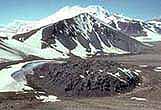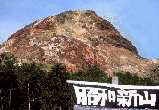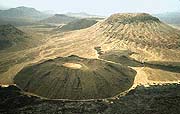
Although felsic lavas are generally associated with explosive Plinian-type eruptions, they sometimes extrude at the surface as relatively cold, viscous lava domes. Vesiculation during eruption will deplete the magma in volatiles, thus depriving the magma of the very gases needed for a sustained eruption. As the eruption wanes, this degassed magma will rise up the central vent where it extrudes at the summit crater as a massive plug of viscous lava. The process is analagous to a slow-moving plug of toothpaste extruding from a toothpaste tube. In rare cases lava domes can erupt independently through fractures unassociated with a central-vent volcano. Several such domes are present in the Mono Lake-Inyo Craters volcanic chain in east-central California; this chain has erupted four lava domes in the past 700 years.
Three examples of lava domes, from Alaska, Japan, and Saudi Arabia are shown below. For a spectacular 3D simulated view of a lava dome, click Mt. St. Helens lava dome.

|

|

|
|
|
|
|
The morphology of lava domes is variable. They are typically thick, steep extrusions, but their shapes can vary from circular, low-profile domes (tortas) to cylindral spines with thick talus slopes (Peléean domes). Less sluggish types are gradational to lava flows and are sometimes referred to as dome flows or coulées. Lava domes have compositions ranging from basaltic andesite to rhyolite, although most are composed of crystal-rich dacite. Some lava domes erupt obsidian (volcanic glass), which forms when magma is cooled so quickly that individual minerals do not have time to crystallize from the melt.
Slowly rising lava domes may grow for months or for several years in the aftermath of explosive eruptions. The earth's longest historical dome-building event has generated the Santiaguito dome in Guatemala. This viscous lava dome began to erupt in 1922 and is still growing today! An empirical example of dome growth through time is shown in the illustration below for the Mt. St. Helens lava dome from 1980 to 1983.
|
|
|
(click image for a more thorough explanation) |
The slow growth of mature lava domes is generally nonexplosive. However, younger domes composed of lava that is not entirely degassed, may occassionally explode. The periodic explosion or gravitational collapse of these viscous masses can sometimes generate deadly pyroclastic flows. These avalanches of hot lava fragments and toxic gases have killed thousands of people throughout history. For a more thorough explaination of dome-collapse pyroclastic flows, link to nuée ardentes.
![]() Intermediate to advanced
users may be interested in this numerical program of lava dome
growth developed by Dr. Jon Dehn. Click image to download the
model.
Intermediate to advanced
users may be interested in this numerical program of lava dome
growth developed by Dr. Jon Dehn. Click image to download the
model.